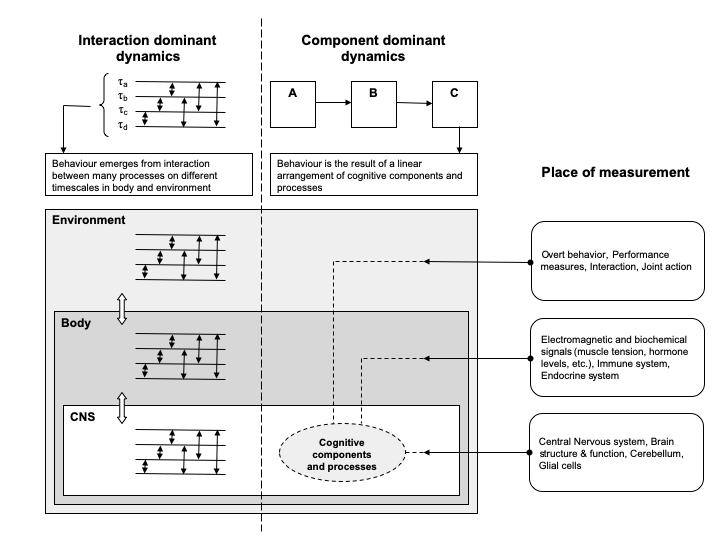2.3 Component- vs. Interaction-dominant Dynamics
A helpful framework for discussing the differences between a Complex Systems Approach and a Machine Metaphor Approach to the scientific study of human behaviour is to describe the causal ontology used to explain behaviour. Familiar “degrees of causation”, or entailment are possible in component dominant dynamics, such as uniquely explained variance, beta weights or effect sizes. In general, a linear arrangement of partial causes always neatly sum up to produce the behaviour of interest. An alternative causal ontology is interaction dominant dynamics in which not the components themselves, but their interactions as a whole are the source of the observed behaviour (Ihlen & Vereijken, 2010; Kello, Beltz, Holden, & Van Orden, 2007; Van Orden, Holden & Turvey, 2003; Van Orden, Holden & Turvey, 2005; Wijnants, Cox, et al., 2012). Here the contribution of components is not additive, but multiplicative and nonlinear (Holden et al., 2009; van Rooij, Nash, Rajaraman, & Holden, 2013). Such interaction dominant dynamics render individual component behaviour (which are still posited to exist), such as poor performance on ability X, impaired representation of that feature Y, as a less interesting object of theoretical and empirical inquiry.

As a consequence, theoretical and empirical inquiry is aimed at identifying and understanding the contexts in which impaired behaviour emerged. Adopting such a perspective entails that all observable behaviour can only be understood relative to the context in which it was observed, that is, the measurement context (cf. Holden, Choi, Amazeen, & Van Orden, 2010; Van Orden, Kello, & Holden, 2010). Figure presents the fundamental differences between the two ontologies in their assumptions about the causes of behaviour and their assumed place of measurement. Figure may reveal why the nature of cognitive components and processes remain elusive in their causal role. They are inferred, not postulated, based on data from different places of measurement. Their causal structure does not incorporate the nested nature of both measurements as well as posited entities. Applying the concept of the complex conditional reveals hierarchical dependencies of one condition on another and such a complex, if it were composed of the correct conditionals, should be considered as a whole. As a consequence, impaired behaviour should be understood as emerging from the whole of constituent components, not from an individual component. The notion of a cause is somewhat more radical than the complex conditionals and is known as impredicative, circular causation (Chemero & Turvey, 2010; Freeman, 1999; Turvey, 2007), or nested causation.